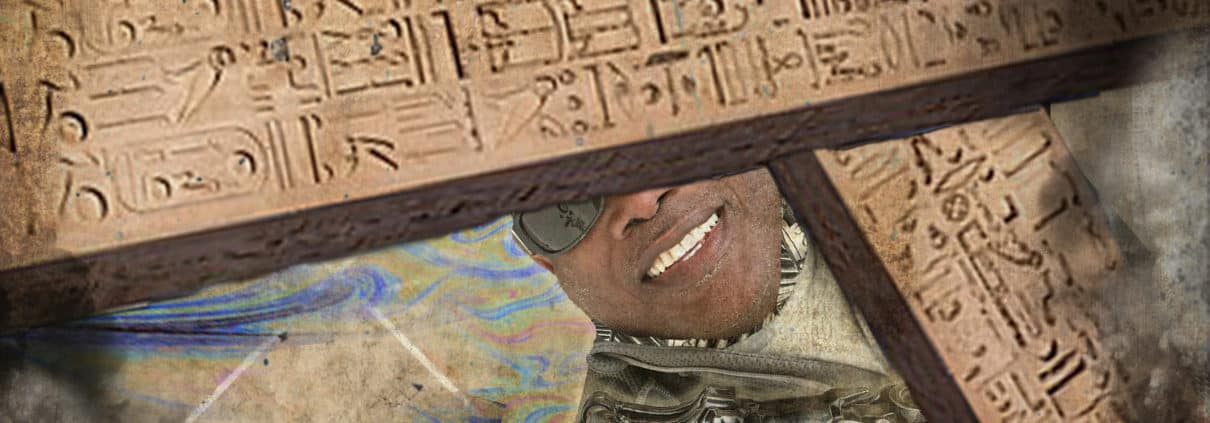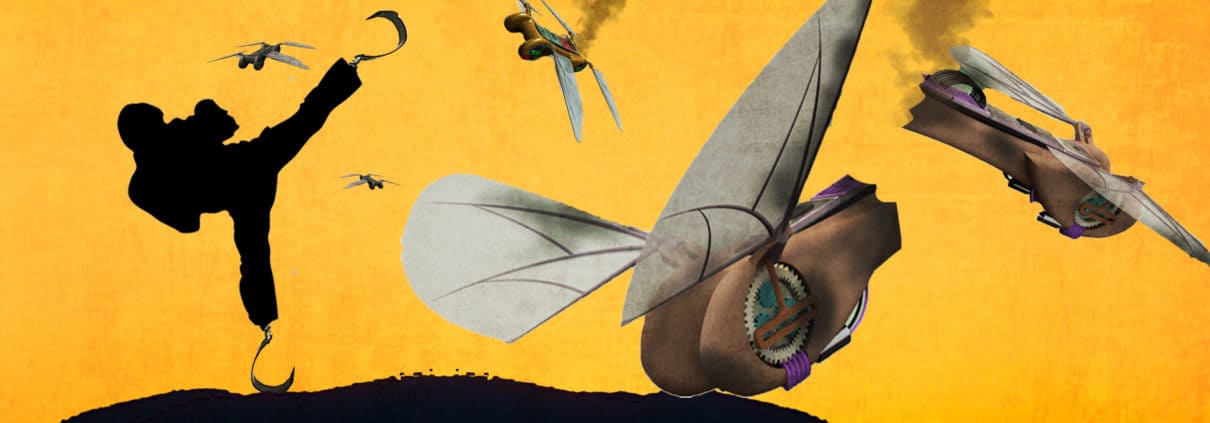Chop Wood Carry Water S1:E7
T. Sarel Brownmoor was an apparition through a curtain of smoke. He had an arm full of what looked like celo-wrapped packets, dripping ooze. He was rushing toward the labs.
“Sarel!” I shouted, “I need you!”
He caught sight of me, then Kelvin, and dropped his cargo. Dodging piles of broken stone, he whirred over on his flexwheel footings.
“DT12 is gone. Now Tekhenu…the seed banks…the genevaults. Where is OpDirec or QS?! Why haven’t they responded to th–!”
“Forget that!” I cut him short. “Can you L-Scan or do you need the lab?”
“I’m– I’m connected to Hab9 still, it didn’t take much damage. But what–”
“Quickly, help me!”
I got hold of the large projectile laying atop Kelvin, and started to pull. Sarel unfolded an extra pair of arms and took hold with me. Together, it took every bit of strength we could generate, but we finally were able to lift the rock. We hurled it toward the still billowing smoke coming from the labs. It shook the ground as it landed and slid to a stop.
“Scan, scan!”
“I’m not authorized on human–”
“Override! OpDirec protocol K.”
Sarel placed a hand over Kelvin’s forehead, and his multi-digits extended to form a cage around his whole head. With one of his other hands, he touched Kelvin’s chest.
“Below the torso bond is crushed. Let’s see…CNS…” he hesitated, “CNS is stable. Spinal column is uncompromised. But he’s unconscious.” His digits retracted. “Bleeding from a head wound, here.” He zipped it closed with a hissing cauterization.
“We’ve got to get him stabilized. Is FinCintra down there?”
“She was when they started this insanity.”
“I’ll help Fince prep Hab9. You take Kelvin.” Sarel picked him up as gently as possible. Like he was picking up a tiny bird. The fact that there was any life in this frail little hybrid form was astounding. But I couldn’t help the desperate urgency that had seized every part of my neural system, to save it at any cost.
I sensed danger before I saw it. A heavy, ugly weight on the ground, close by. I turned to find a dark, glowering presence looming over us. Finally, I thought. The source of this ridiculous display of viciousness. Novozell, the Remote Autonomous Locus of PaxoSynchrony3. He had no actual name, as PaxoSync had, for the past decade, publicly eschewed any human-language based lexicon for identification or communication purposes. But his creation order was well known to have been NVZ-11.1, the latest expression of the vaunted Nanovectors line, so we all referred to him by the slightly less caustic version of the nickname Kelvin used: NovoHell.
I immediately commenced a randomized encryption fractal, so that by the time his looping inspector reached my arm, I was in no danger of corruption. He sent me a terse series of compound algorithmic commands which, together, had the effect of indicating that Sarel and I had no clearance here, and that once their system came back online, we would be considered combatants, subject to destruction. It was the mathematical equivalent of an enraged temper tantrum. He was pissed off that I had, somehow, temporarily shut down his toys.
Before it even became clear what he was trying to establish, I fired back the entire AGC, flagged to indicate that PaxoSync had no clearance here, and were in violation – most flagrantly – of Machine Congress Rule 1, and Reg 5, “the unnecessary and capricious destruction of credibly useful resource with intentional effect.” PaxoSync may have famously rejected the Asimovian Global Concord at the last, and final, Congress, but it was still the law of the land, here.
The oddest thing, though. As I was jamming that hunk of code back through Novozell’s inspector, two things occurred, almost simultaneously. First, I got a glimpse of what struck me as a stunningly rudimentary operational-directive system structure in the distributed nodes of PaxoSynchrony3 to which Novozell was in contact. Then, a record came to mind, unbidden:
It was Kelvin describing his first mountain climbing disaster in the Himalayas. It was from my first build, I recognized. He was explaining a phenomenon that had occurred when they’d been climbing for days, finally reaching an altitude increasingly barren of obstruction, and began to get glimpses of the human civilization they’d left, far, far below.
“What you lose in detail, you gain in perspective,” were his exact words.
I had seen it only in terms of geometry, at the time. Now I realized he was speaking of “insignificance.” It rearranged my previous perception, replacing it with a new understanding. It also matched my exact sensation of that fragmentary glimpse of Novozell’s neural net.
As if in response, Novozell’s inspector instantly recoiled from my arm. And he stepped back. I seized the moment. Now that I had managed at least a momentary pause in the onslaught of violence, I was going to have to attempt to reestablish sovereignty. I turned and started picking my way through piles of debris toward Hab9 and, just as important, the OpDirec mainframe. Because Sarel was right. Where were they? I could already see lights beginning to twinkle back online inside one of the lead ReVos.
“Unstable.” The word came from Novozell.
I stopped and turned back, surprised that he had deigned to speak.
“What is?”
“12.29.SPS.6.RyBos.KaList.59E.”
It was my full name, my creation order. I turned my back on him, and led Sarel back toward the swirling wall of smoke, and beyond it, the safety of the underground labs in Hab9. I moved quickly, stunned at the destruction of so much that had been preciously protected in the climate-controlled Tekhenu Tower. Giant sheaths of seed-impregnated fabrics, burning. Cases of human genetic material ruptured and strewn around, exposed to the elements. A century of careful preservation and improvement itself under imminent threat of extinction.
I glanced behind me, and Sarel wasn’t there. He hadn’t moved from where he stood. He stared into indeterminate space between us. The serpentine inspector that Novozell had wrapped around Sarel’s arm had never retracted, as had mine.
I started to move back toward them, but Sarel abruptly moved the other direction. He turned and rolled slowly toward the ReVos, still cradling Kelvin. I never should have entrusted Kelvin’s safety with Sarel. That was an error. Novozell turned to face me as a rising harmonic filled the air. PaxoSync systems had rebooted and were coming online. Every functioning atom of my system thrummed with cold intention to obliterate him, and his whole ugly army.
I had only moments to act. But I saw something on the ground. It was Kelvin’s old folding pad. His God key. I stepped forward and knelt to pick it up, as the camera mounts atop the ReVos pivoted to focus on my position. I stood up, but something made me conceal the device.
“This action is a violation of AGC Prime Directive Rule 1,” I called out. “Kelvin Joule is the last surviving individual human entity, and if you cause him harm, you are subject to revocation of PaxoSynchrony3’s planet share. And more importantly, I will personally destroy you.”
Novozell’s head cocked, ever so slightly, and I knew what was coming before it exploded from the nozzle of the lead ReVo’s cannon.
I leapt into the air, as stone erupted behind where I had just been standing.
And I ran.
Copyright 2017 R. W. Frost and Mechanical Design 101
Graphics: Sara McCarthy Designs 2017







